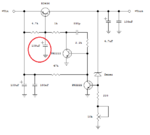neazoi
Advanced Member level 6
Hi, this is a more powerful version of the well known thrifty regulator.
I was wondering if I could add a base capacitor (shown in red circle) to make it also a capacitor multiplier (https://www.radio-electronics.com/info/circuits/transistor/capacitance-multiplier-circuit.php), so that some ripple can be filtered out?
Can I do that?
Also, is the capacitor polarity ok?
I was wondering if I could add a base capacitor (shown in red circle) to make it also a capacitor multiplier (https://www.radio-electronics.com/info/circuits/transistor/capacitance-multiplier-circuit.php), so that some ripple can be filtered out?
Can I do that?
Also, is the capacitor polarity ok?
